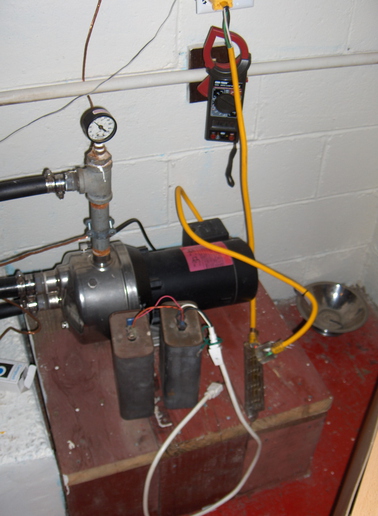Geo-TH,In
Well-known Member
There has been a lot said about power factoring motors, so I had some time to play in my cool basement. My well has a 3/4 hp A O Smith pump. It operates on 120v. I put a 12 gauge cord on it by buying a 6 ft extension cord and cutting 3 ft off the end. Took the other end of the cord and put a plug on it. Removed some of the insulation so I could put ammprobe around the power wire. Plugged my pump in the end of my 3 ft extension cord.
To my surprise, when the pump kicks on around 20 psi, my amp draw is close to 15 amps. As the pressure builds, the amp draw decreases to 12.2 amps. The more the pressure, the less the amps. That seems odd to me, I would have thought just the opposite.
I have 2 55 mic 440 Volt capacitors. By connecting a capacitor to the end of the white cord, I could plug the capacitor into my 3 ft extension cord and also have the well pump plugged into the same cord. This puts the 55 mic in parallel with the pump and the total current decreased by 1.1 amps. Putting the second 55 mic cap in parallel with the first, my total current went from 12.2 amps to 9.99 amps. I was impressed with my results. Even had a little excitement too, especially after unplugging the capacitors and shorting them. I confirmed the big ban theory.
Going to get a metal box, some bleeder resistors, fine tune the bank of capacitors for minimum current and install them on the side of the switch where the pump is connected.
Next I tried to power factor a 4 peak hp electric chain saw. My results were the opposite of my well. Adding any size capacitor caused my total current to increase. I started with a 4 mic and stopped with a 55 mic.
So, are you not able to power a universal motor?
Are you not able to power factor a universal motor that's not under load?
I'm sure there are some will say that I don't have a clue what I'm doing, so I'll put that out there as one of the options.
Like to hear what are EE, John T thinks too.
George


To my surprise, when the pump kicks on around 20 psi, my amp draw is close to 15 amps. As the pressure builds, the amp draw decreases to 12.2 amps. The more the pressure, the less the amps. That seems odd to me, I would have thought just the opposite.
I have 2 55 mic 440 Volt capacitors. By connecting a capacitor to the end of the white cord, I could plug the capacitor into my 3 ft extension cord and also have the well pump plugged into the same cord. This puts the 55 mic in parallel with the pump and the total current decreased by 1.1 amps. Putting the second 55 mic cap in parallel with the first, my total current went from 12.2 amps to 9.99 amps. I was impressed with my results. Even had a little excitement too, especially after unplugging the capacitors and shorting them. I confirmed the big ban theory.
Going to get a metal box, some bleeder resistors, fine tune the bank of capacitors for minimum current and install them on the side of the switch where the pump is connected.
Next I tried to power factor a 4 peak hp electric chain saw. My results were the opposite of my well. Adding any size capacitor caused my total current to increase. I started with a 4 mic and stopped with a 55 mic.
So, are you not able to power a universal motor?
Are you not able to power factor a universal motor that's not under load?
I'm sure there are some will say that I don't have a clue what I'm doing, so I'll put that out there as one of the options.
Like to hear what are EE, John T thinks too.
George



